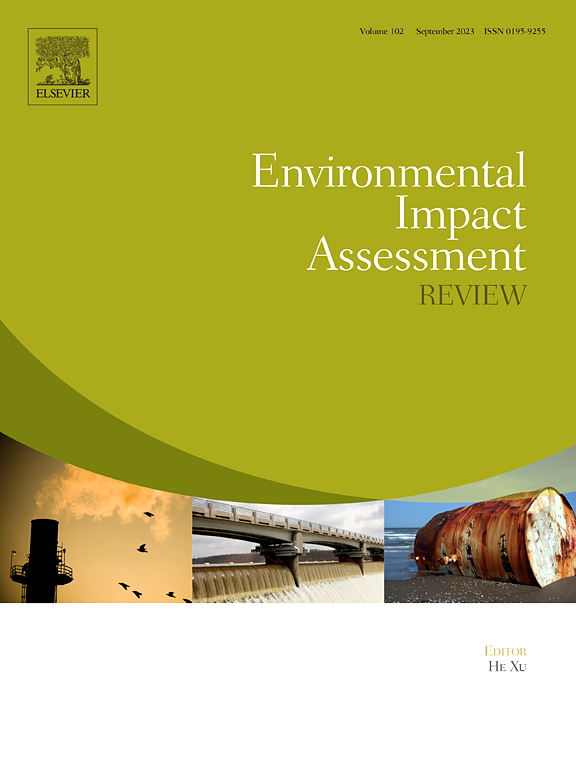Does enhanced land use efficiency promote ecological resilience in China's urban agglomerations?
IF 11.2
1区 社会学
Q1 ENVIRONMENTAL STUDIES
引用次数: 0
Abstract
Urban agglomerations are critical regions where the demand for land expansion often conflicts with the need to maintain ecological resilience (ER). Enhancing land use efficiency (LUE) is considered a key strategy for improving ecological infrastructure, reducing ecological pressures, and optimizing the spatial structure of ecosystems, all of which are essential elements of ER. However, existing research has largely neglected the relationship between LUE and ER, typically focusing on the development patterns of ER within individual urban agglomerations. Comparative studies on how ER responds to LUE across different stages or sub-regions are limited. Understanding how LUE enhances ER can support the coordinated goals of ecological conservation and efficient development in urban agglomerations, providing a scientific basis for their sustainable development. This study aims to develop an evaluation system for ER and LUE at the county level across 19 Chinese urban agglomerations from 2000 to 2020, analyzing their spatial-temporal evolution patterns. Using an analytical framework that addresses the overall situation, classified agglomerations and internal cities and employing machine learning algorithms, this study compares the mechanisms by which ER responds to LUE across these urban contexts. The findings reveal that: (1) The average county-level ER increased by 5.1 %, with Mature Urban Agglomerations demonstrating significantly higher ER compared to Nurtured or Developing Urban Agglomerations. Notably, Developing Urban Agglomerations showed the fastest growth at 12.9 %. Core areas exhibited a 9.6 % higher ER and a 15.2 % greater growth rate than peripheral areas. (2) LUE increased from 0.199 to 0.248 during the study period, following the pattern: Nurtured > Mature > Developing urban agglomerations. (3) The non-linear relationship between LUE and ER varied significantly across different development stages, with the most pronounced effects observed at LUE levels of 0–0.3 and above 0.5. The positive influence of LUE on ER intensified over time, particularly in regions with greater centrality and development. These findings provide actionable recommendations for ecological coordination focused on ER, land management policies, and spatial planning. This study highlights the significance of urban-rural strategies for enhancing ER, offering quantitative insights and a robust foundation for sustainable land management in China's urban agglomerations and beyond.
土地利用效率的提高是否促进了中国城市群的生态弹性?
城市群是土地扩张需求与维持生态恢复力(ER)需求经常发生冲突的关键区域。提高土地利用效率是改善生态基础设施、减轻生态压力和优化生态系统空间结构的关键策略,是生态效率的基本要素。然而,现有的研究在很大程度上忽视了城市效率和效率之间的关系,通常侧重于单个城市群内部效率的发展模式。关于不同阶段或分区域的ER如何响应LUE的比较研究有限。了解城市效率与效率之间的关系,可以为城市群生态保护与高效发展的协调目标提供支持,为城市群可持续发展提供科学依据。以2000 - 2020年中国19个城市群为研究对象,构建县域生态效率和生态效率评价体系,分析县域生态效率和生态效率的时空演变规律。本研究使用一个分析框架来解决总体情况、分类集聚和内部城市,并采用机器学习算法,比较了这些城市背景下ER响应LUE的机制。结果表明:(1)县域平均内耗比上年增长5.1%,成熟城市群的内耗显著高于培育城市群和发展城市群;值得注意的是,发展中城市群增长最快,达到12.9%。核心区的ER比外围区高9.6%,增长率比外围区高15.2%。(2)研究期间,LUE从0.199增加到0.248,其变化规律为:成熟的祝辞发展城市群。(3) LUE与ER的非线性关系在不同发育阶段存在显著差异,在LUE水平0 ~ 0.3和0.5以上时影响最为显著。LUE对ER的积极影响随着时间的推移而增强,特别是在中心性和发展程度较高的区域。这些发现为生态协调、土地管理政策和空间规划提供了可操作的建议。本研究强调了城乡战略对提高城乡效益的重要性,为中国城市群及其他地区的可持续土地管理提供了定量的见解和坚实的基础。
本文章由计算机程序翻译,如有差异,请以英文原文为准。
求助全文
约1分钟内获得全文
求助全文
来源期刊

Environmental Impact Assessment Review
ENVIRONMENTAL STUDIES-
CiteScore
12.60
自引率
10.10%
发文量
200
审稿时长
33 days
期刊介绍:
Environmental Impact Assessment Review is an interdisciplinary journal that serves a global audience of practitioners, policymakers, and academics involved in assessing the environmental impact of policies, projects, processes, and products. The journal focuses on innovative theory and practice in environmental impact assessment (EIA). Papers are expected to present innovative ideas, be topical, and coherent. The journal emphasizes concepts, methods, techniques, approaches, and systems related to EIA theory and practice.
 求助内容:
求助内容: 应助结果提醒方式:
应助结果提醒方式:


